|
Our
Grandfathers' Wars
or
By
George!
Parallel Lives in the
British
Army a Hundred Years Ago
Part
III: Early Days and Darkest
Hours
by
Peter Hunt
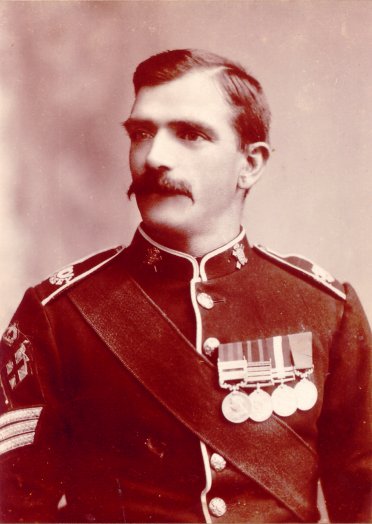
George
Barnett
He
wears the Queen's India Medal, The Queen's and the King's South Africa
Medals
and
the Long Service and Good Conduct Medals
It
is always reassuring to receive feedback on the articles in Despatches.
Knowing that
someone, somewhere in cyberspace, is actually reading this stuff is a reward
in itself. Since I wrote Parts I
and II of this series I had done some more work on my Grandfather’s
military life and had visited the South African battlefields in 2000.
I was thinking about going into print again, when I received a nice
email from Mrs Sheelagh le Cocq of Jersey, the
Channel Islands. Like me, Mrs le Cocq never knew
her grandfather but she had researched his life through family histories and
newspapers. Like my grandfather,
his name was also George and the two men had the same medal groups for their
military service, although Mrs le Cocq’s grandfather George Barnett served
in the Royal Inniskilling (although the town is Enniskillen) Fusiliers,
whilst mine, George Hunt, served in the Devons.
In Part II I related how George Hunt had been besieged in Ladysmith.
George Barnett was one of the men trying to relieve Ladysmith.
Both Georges then went on to fight the Boers on their own ground.
Although neither Mrs le Cocq nor I have any evidence that the two
Georges ever met it is clear that their paths crossed several times.
This, as they say, is their story . . .
For
a well spent 25 pounds sterling in 1997 I had a researcher get me copies of
my Grandfather’s service record and the
Devon
’s medal rolls. These filled
in many of the gaps in my knowledge of him, telling me where he was born,
what he did before he joined the army, and where and when he served.
Oddly enough on not one of the forms is his birthday recorded.
Clearly the army had no intention of throwing him a little party once
a year. But, since George H was
listed as 19 years and 10 months old when he signed up in November 1891, that
means he was born in January 1872, in the
village
of
Northam, Devon. George B was born three months
later in Islington, London.
Whilst
George Hunt lived with his father, became a groom and also served in the
part-time Militia until he joined the Devons when he was nearly 20, George
Barnett had a much rougher start to life. Mrs le Cocq suspects that George
may have been born out of wedlock because his father is described as a
“bachelor” in a later marriage certificate. No doubt, since he rose to
be a Senior NCO in the British Army, some of the privates that he was
responsible for keeping in discipline would have thought that this
background was an essential prerequisite for the job! George’s mother died
when he was very young and his father took a new wife who George didn’t
get on with. George later claimed that he had joined the army to escape a
“wicked stepmother,” but Mrs le Cocq charitably points out that the poor
lady had seven children in as many years, one of whom had died, and raising
this brood on a cab driver’s pay would have left Mrs Barnett harassed and
exhausted. When he was 11 George was sent to the Middlesex
Industrial
School, for continually running away from home. The Industrial Schools were
intended for unruly, but not delinquent or criminal boys, and most lads from
these schools entered the army. Mrs le Cocq doubts if they had much choice.
So, at the age of 14 years and 11 months in 1887, young George Barnett
signed on with the 2nd Battalion Inniskillings at
Aldershot, committing himself to 12 years’ service. It is an interesting insight
into the physical condition of working class boys in Victorian London that
George’s medical record shows the nearly 15 year old to have been 4feet, 6
½ inches tall and weighed only 77 pounds.
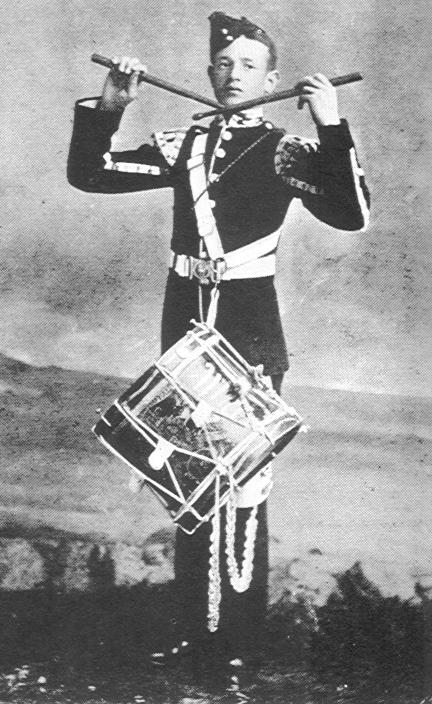
A
Victorian Band Boy similar to George Barnett
At
his age George Barnett would have been a band boy, playing the bugle, drums
and, because this was an Irish Regiment, especially the fife.
We know that George could play the trombone before he entered the
army so it is highly probable that he was in the Regiment’s band when they
marched past Queen Victoria
at her Jubilee Review in July 1887. This
was the easy sort of soldiering that Kipling alluded to when he wrote:
“You
may talk o’ gin and beer
when
you’re quartered safe out ’ere,
An’ you’re sent to penny-fights an’
Aldershot
it,”
but
by the end of the following year George was on a troopship bound for India
where he would have plenty of opportunity to practice the band boys’
secondary duty ~ they were stretcher bearers.
On
a personal note I thought that the Orient was amazing when I arrived in
Hong Kong
at the ripe old age of 22. You
really have to wonder what the 16-year-old George Barnett thought of it all
when he stepped ashore in Bombay in January 1889. He probably
didn’t have much time to think. The
battalion quickly moved to its station at Secunderabad and, after nearly
three years there, moved on to the even more exotic Burma where it spent the next four years. By
this time Private George Hunt of the Devons was catching up.
He arrived in
India
in December 1892, two months after his namesake had moved to Burma. By this time George Barnett
would also have become a fully-fledged infantryman.
The
two George’s first campaign together came in 1897 in the Tirah, which is
related in Part I of this series. The
Devons were in the main assault force under General Lockhart, whilst the
Inniskillings covered the flanks as part of the “Peshawar Mobile
Column,” based on Fort Bara. Here, according to their historian, they longed
“to be more actively
employed than in the necessary but uninteresting duties of road making and
fortifying the camp.” Their chance came when Lockhart’s regiments
withdrew and the Peshawar Column had to advance to save the hard-pressed rearguard.
This operation was a classic example of mountain warfare. The
Inniskillings and their sister battalions from the Peshawar Column entered
the hills and, passing through each other in succession secured the heights
for the rearguard to pass through to safety.
After being pursued by fanatic Afridis for five days and nights the
Scots, Sikhs and Gurkhas of the rearguard must have been rather pleased to
see the Irishmen, and Londoners, of the Inniskillings.
The interesting thing of course is that probably none of the English,
Irish, Scottish, Indian or Nepali brothers-in-arms who bivouacked at Barkai
on 14th December 1897 gave a moment’s thought to what an
amazingly diverse, but perhaps wonderful, Imperial army they composed.
George
Hunt’s enlistment papers are full of small print.
Whilst, theoretically, he signed on for seven years active duty,
“with the colours”, and five in the reserve, the sub-clauses provided
that, if the active service was overseas it could be extended by one year.
And if a state of war existed then, by yet another year.
And if “by a proclamation from Her Majesty in case of imminent
national danger” then all the service could be active, and it could be
extended for yet another year! My
Grandfather fell foul of every one of these clauses.
In December 1898 he was overseas in
India
and in December 1899 definitely at war in
South Africa. I don’t know if this
bothered him unduly, but as an old soldier he had a right to grumble and
I’m sure his contractual obligations gave him lots to grumble about.
George Barnett probably wasn’t grumbling about conditions of
service. At some point he had
decided that the Army was the life for him.
He had signed on again and by 1899 had been promoted to Sergeant.
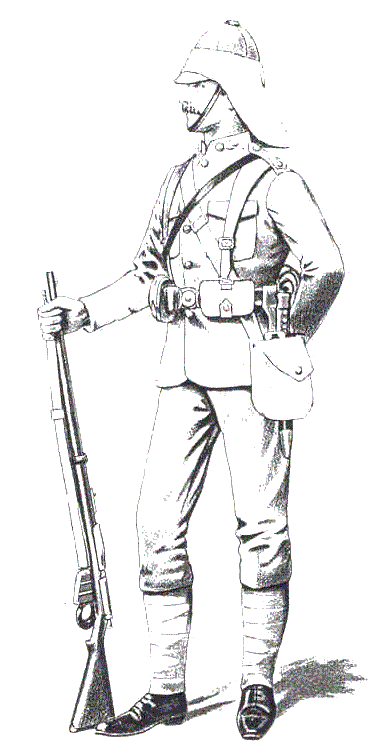
A
private in marching order on the NW Frontier.
The
Devons wore the same kit in South Africa.
The
Devons and George Hunt arrived in South Africa on 21st September 1899 and in Part II I have related how they
soon found themselves besieged in Ladysmith.
George Barnett had been back in England
on leave when war broke out. He
was drafted into the 1st Battalion Inniskillings and arrived in Cape Town
on 30th November 1899 as part of Buller’s Army Corps which was
charged with breaking the Boer line on the Tugela River
and relieving Ladysmith, and my Grandfather.
Buller’s
first attempt at breaking through was at the Battle of Colenso on 15th
December 1899. The Boers, 4,500
strong under probably their best commander, Louis Botha, were dug in on the
north bank of the Tugela. Unfortunately
for the British, Buller had no real idea where they were.
His maps were wrong and this had not been revealed by careful
reconnaissance. Buller had
15,000 men in five brigades. Two,
(which included the 2nd Battalion of the Devons, trying to
relieve their 1st Battalion in Ladysmith) were to remain in reserve, one
was to attack on the right and one was to make a frontal attack on the
bridge across the river. The
other, the Irish Brigade under the command of Major General Arthur Fitzroy
Hart, including the Inniskillings, was the left prong of the attack.
Hart was ordered to cross the Tugela where it made a 300-degree loop
at “Bridle Drift [ford], immediately west of the junction of Doornkoop
Spruit [stream], and the Tugela.”
The
maps showed the junction to be upstream of the loop whereas in reality it
was downstream of it. Thus the
British thought that they would be crossing a drift at the outside of the 7
o’clock position on the loop when the drift they really wanted was at the
inside of the 4 o’clock position. Matters
were made worse because their African guide thought that they wanted to
cross a drift at the 12 o’clock position, and because the approach march
was conducted in the pre-dawn darkness.
Hart’s
nickname was “General No-Bobs” a direct and simple reference to the
fact that he never ducked when bullets and shells passed overhead, but also
perhaps an indirect and cleverer reference to the fact that he was certainly
not a thinking general like Lord Roberts, the other “Bobs”.
He had a
fondness for foot drill and kept his brigade in close formation. Even when
obliged to put them in extended order he sent out markers first to ensure
that the extended order was nice and neat too! Personally he was absolutely
fearless, almost to the exclusion of common sense. But his main problem as a
commander was that he expected everybody in his brigade to be absolutely
fearless almost to the exclusion of common sense too.
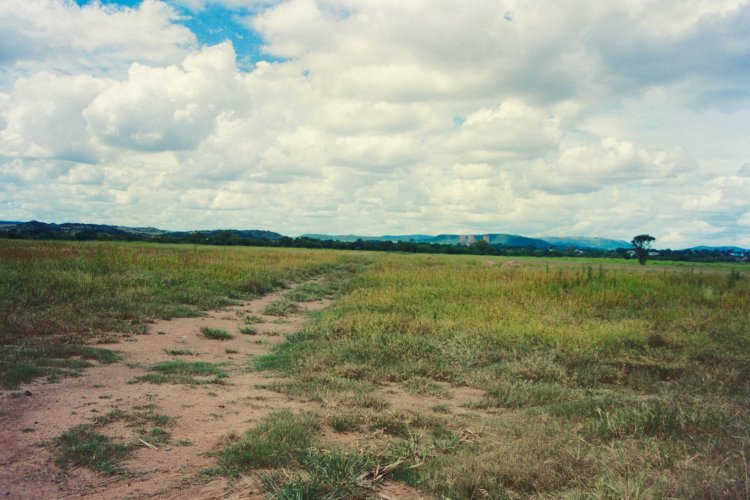
The
ground in the "Loop". The trees roughly mark the
river. The Boers were in the kopjes behind.
During
the approach Hart was informed three times by his cavalry scouts that there
were enemy on his left, where they shouldn’t have been, but he chose to
ignore the scouts. When he hit
the western base of the loop he realized that the map had misled him but,
since his guide insisted that the drift was straight ahead, he ordered the
Brigade forward. Dawn found them
tightly packed inside the loop. The
ground is dead flat and since the river cuts deeply into the plain its exact
position cannot be determined until you are almost right on top of the
banks. Hart, the Inniskillings
and George Barnett had the river on three sides and Boer marksmen and
artillery concealed in the kopjes beyond the river to their left and front.
The result was a massacre. A
soldier in one of the Inniskillings’ sister regiments in the brigade, the
Dublin Fusiliers, described it thus:
“For
hours, around these gallant lads, the shot like hailstones fell,
And
many a bullet found its mark in that infernal hell;
With
sad downcast face we heard the order to retire,
The
position was too strong to take beneath that falling fire . . .
Then
here’s to the gallant Dublins, and the brave old Connaughts too,
The
Border lads undaunted, and the Inniskillings true,
Side
by side, they fought and died, each man beside his “pal”,
Fighting
for
England
’s honour on the border of Natal.”
The
rest of the battle was little better from the British point of view.
The attack on the bridge was suicidal and when two batteries of
British guns advanced to support it they came into easy rifle range of the
Boers, were devastated by Mauser fire, ran out of ammunition and had 10 guns
captured. To add further insult
to the injury of the British Army that day, two companies of the 2nd Battalion of the Devons did not receive the order to retreat and were
overwhelmed, taking 102 casualties and losing 36 prisoners, including the
battalion’s colonel.
In
total 1,139 of Buller’s men were killed, wounded or captured at Colenso,
and 553 of those casualties were from Hart’s Irish Brigade.
Today the dead lie in a well-tended cemetery inside the loop.
The fatal kopjes look down in the distance, and across the billiard
table flat ground of the loop you still can’t see the river.
This is a site that should be visited by every army officer to drum
home the maxim: “Time spent in reconnaissance is seldom wasted”.
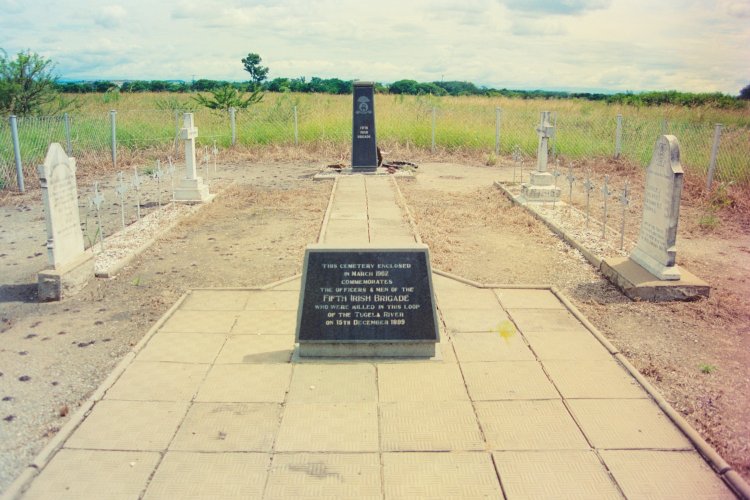
The
Irish Brigade cemetery
Uncharacteristically
Buller tried to shift the blame for the defeat.
“I was sold by a gunner”, he complained, although the gunners
certainly had no responsibility for Hart’s disaster.
Buller anguished for three days about sacking Hart but eventually
decided against this. Hart could
not understand what all the fuss was about.
He put his failure down to his soldiers going the ground but he
himself “took a cheerful view of it, ascribed it to first experiences
under fire, and said they would do much better next time”.
Botha’s view of George Barnett and his comrades was higher than
their own general’s: “I must say that I never saw anything more
magnificent than their charges at this point . . . no less than five times
they charged, and I never want to see finer bravery than I saw there” he
wrote. And, characteristically,
Botha made no attempt to take great credit for his opponent’s mistakes.
He simply wrote to President Kruger: “The Lord of our fathers has
today given us a brilliant victory”.
On
11th January 1900 Buller moved west to attempt to outflank the
Boer line. The promising chance
of a cavalry breakthrough was thrown away and by January 20th it
was decided that another infantry assault was necessary.
The attack was directed at a hill called Taba Nyama and once again
Hart’s Irish Brigade, reinforced this time by two
Lancashire
battalions, led the attack. Hart
thought that his brigade had done well because it reached the crest of the
hill, only to discover that it was a false crest and that the ridge of the
hill was still 1,000 yards away, where the Boers were waiting with a clear
field of fire. Writing after the
war, under a pseudonym because he was still a serving officer and he
didn’t pull his punches about what he saw, a Lieutenant-Colonel Grant
described Hart’s response:
“There
is nothing apologetic or doubtful about General Hart to start with, [a]
gallant fiery Irishman, too hot with the ignis sacer [holy fire] of fighting
to see anything ridiculous in a sword angrily brandished at an enemy a
thousand yards away . . . Where
will British privates not rush at the word of command?
[A]nd, in the name of pity, why are such commands given?”
Certainly the likes of George Barnett and his comrades
did not question Hart’s ridiculous gesturing.
Grant relates what happens next:
“The
artillery preparation was mere form. There
was a hasty bang, bang, bang from the artillery . . . and up from the shadows
burst the Irish and North-Countymen with a typhoon of yells and a momentum
that nothing but death could stop. But
death was there: a tremendous fire broke out from the ridge . . . The foremost
men fell in heaps, the rearmost were stopped, as all should have been
stopped, at the crestline. ‘Thus
far, and no further,’ sang the Mausers.”
Hart’s
brigade had lost 365 casualties, mostly, noted Winston Churchill, from the
Lancashire Regiments and the Dublin Fusiliers.
By this time the “Dubs” were down to 50% strength. But the
Inniskillings couldn’t have been much better off.
The battle was renewed the next day and the British made some gains,
but by the evening of the 22nd, by which time another 195
casualties had been suffered, it was clear that they could not break
through. At a council-of-war the
British commanders considered three possibilities: a night assault on the
ridge, which Churchill considered “would involve great slaughter and a
terrible risk”, an ignominious retreat, or to outflank Taba Nyama by
taking the higher hill next to it . . . Spion Kop.

On
the horizon: Taba Nyama (left), Spion Kop (centre) and Twin Peaks (right)
seen
from the British side of the Tugela
The
Battle of Spion Kop on 23rd/24th January 1900 centred
on attempts to take and hold the 1,460 metre high kop.
The Inniskillings remained on Taba Nyama, so I will not go into great
detail. But it is important to
note that this was a battle of wills. Both
sides thought they had lost. Both
sides were right. Both sides
retreated from the top of the kop. Only
Louis Botha wouldn’t give up and, throwing in his last reserve on the
morning of the 25th, the Boers found only British stretcher
bearers collecting wounded and dead on top of the hill.
The Boer will had triumphed.
Two
weeks later Buller tried, and failed, again at the Battle of Vaalkrans, just
east of Spion Kop. Again the
Inniskillings were not heavily engaged so I will not go into details but the
important thing to note is that what a fine instrument of war men like
Sergeant Barnett made for General Buller.
They took their setbacks on the chin; didn’t lose faith in their
commanders, (although Buller must have sorely tested this faith when it came
to his tactical ability, but I believe that the troops really appreciated
his genuine care for them and they repaid this) and kept going forward.
Three significant defeats in six weeks would have knocked the
stuffing out of most armies.
Whilst
George Barnett was suffering south of the Tugela what of George Hunt in
Ladysmith? The main events of
the Siege have been related in Part II, but in 2004 the Naval and Military
Press republished the “Regimental History of the 1st Battalion
Devonshire Regiment during the Boer War” by Colonel M. Jacson which
contains many little sidelights on the siege life of George and his
comrades. For instance:
9th
November 1899: First Boer attack
beaten off. “This lasted until
about 2 p.m., when the action was concluded with a royal salute from the
naval batteries and three hearty cheers which, started by the Naval Brigade,
were taken up all round the defences in Honour of the birthday of H.R.H. the
Prince of Wales. A curious
ending to a battle.” Curious
indeed. I hope that Bertie
appreciated what splendid chaps he had fighting for him.
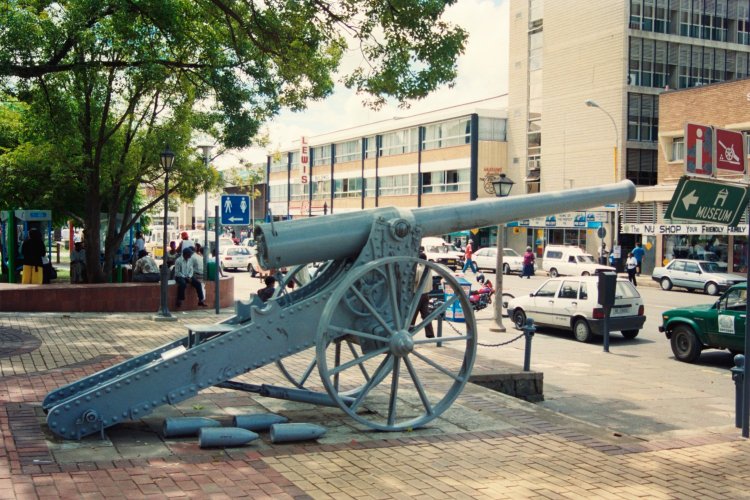
One
of the Boer 'Long Toms' that usually made Private Hunt's life a misery,
but
occasionally fired liquorice
1st
January 1900: In addition to firing 1½ tons of real shells into the town
the Boers fired one “engraved on it 'Compliments of the Season', . . .
[containing] a busting charge of liquorice in place of melanite . . .
[a]nother
blind shell picked up was full of sweetmeats.”
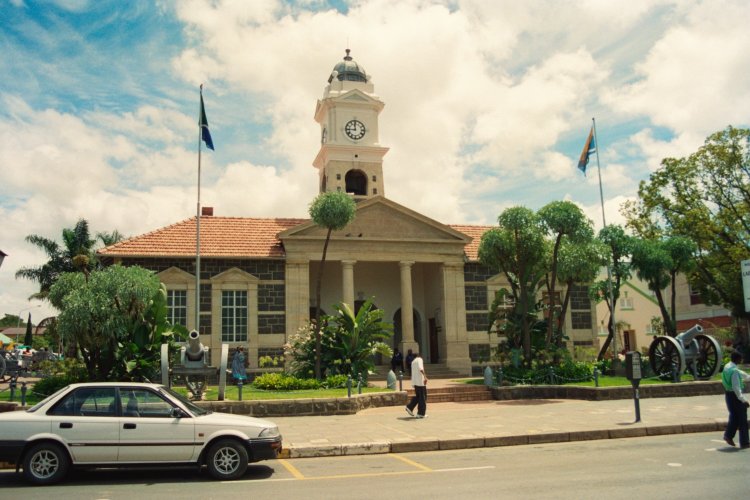
Ladysmith
Town Hall. Private Hunt sat outside whilst Sgt Barnett marched past
1st
January, 1900: “Messages of good wishes to the garrison were received from
Her Majesty, from Sir Redvers Buller, and from the soldiers, sailors and
civilians of
Hong Kong
.” That was nice of us,
wasn’t it?
9th-10th
January 1900: The British
use star shell to illuminate a night attack.
The Boers had never seen them before and were: ". . . hugely elated
at the sight . . . They turned
their searchlight on to the stars . . . and cheered lustily.
They evidently considered that it was a special performance got up
for their entertainment . . .”
31st
January 1900: “horse-flesh was
issued for the first time as a ration.”
3rd
February1900: “a decoction
called 'chervil' [a pun on the popular beef essence 'Bovril'] was
issued to the men. It was
supplied by the 18th Hussars’ horses, whose bodies were boiled
down for the purpose. It was
nourishing and the men liked it, which was a good thing.
There was nothing else by which to recommend it.
The men were also allowed to go down to the chervil factory . . . and
buy the horseflesh after it had passed through the boiling process.
This did not appear appetizing, but
again the men liked it . . .” My emphasis.
Another
odd thing about the siege was that both side’s signalers chatted with each
other. A sort of fraternization
with the enemy by heliograph. When
news of the new diet got out the Boers signaled: “How do you like
horse-meat?” The British
flashed back: “Fine. When the
horses are finished we are going to eat Boer.”
Lest
all this sound too jolly, by the end of February starvation was a real
threat for the garrison and disease was knocking them down.
There were 13,500 men in Ladysmith and over 10,500 admissions to
hospital over the three months of the siege.
Despite the 'stiff upper lip' the strain was telling and 'reading between the lines' of Jacson’s account we find that even
strongly held fundamentals that had probably never even been thought about
before, were being questioned:
4th
February 1900: News received
that Buller “was to be expected shortly, and . . . that . . . Ladysmith was to
be attacked again next morning by 10,000 Boers.
Arrangements were made to meet the latter, the
arrival of the former being considered hypothetical.”
My emphasis.
13th
February 1900: “Divine Service …
The
usual 'extermination' service and prayers for the 'Right' were said,
the hymns chosen being:
There
is a blessed home
Beyond
this land of woe;
And
There
is a greenhill far away,
Sung
sadly to the accompaniment of Buller’s guns.”
The
reason why the Devons could hear Buller’s guns was because on 12th February 1900 he tried again to break through to Ladysmith.
Although George
Hunt in the garrison, and George Barnett in the relieving force had suffered
so much, so far, both still had more dark hours to go through before the
dawn.
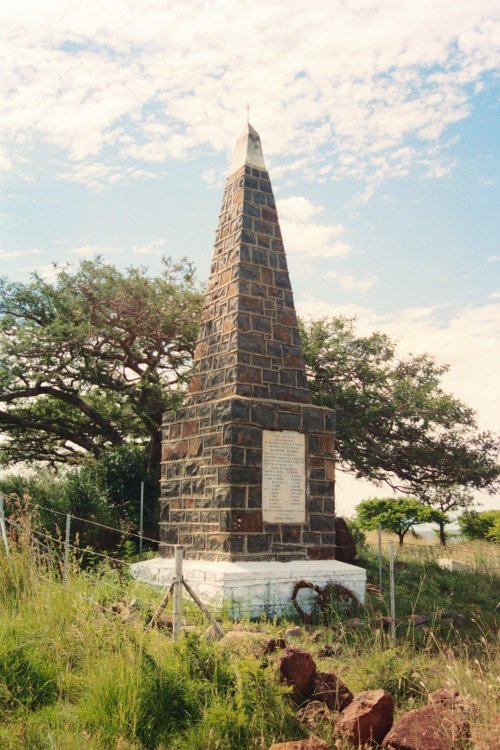
The
Devons' memorial at Platrand, Ladysmith
back
to the contents page back
to colonial wars go
to part 4
|